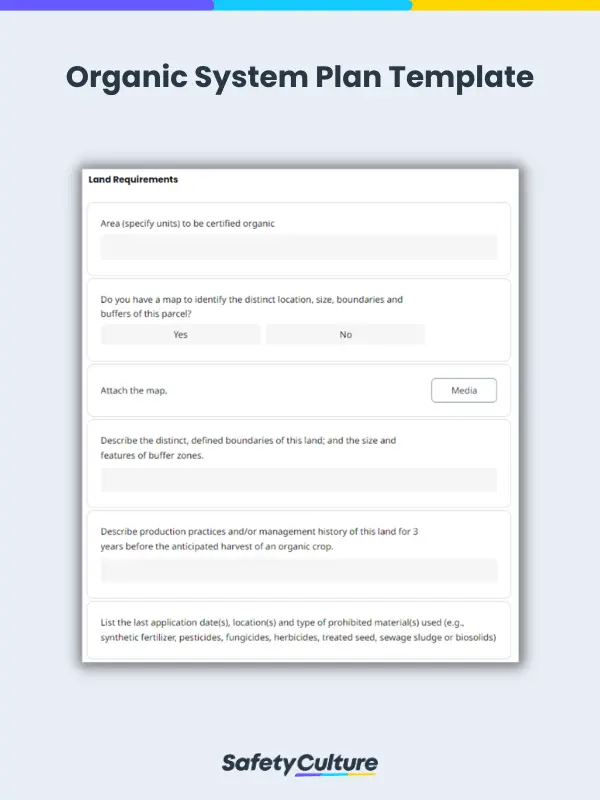What is an Organic System Plan?
An Organic System Plan (OSP) is a comprehensive document that outlines how an operation complies with organic standards to obtain organic certification. Certification is granted when the standards of the National Organic Program (NOP), regulated by the U.S. Department of Agriculture (USDA), are met. Farmers, ranchers, and businesses that sell or label agricultural products as organic should demonstrate the integrity of production and handling practices in the Organic System Plan to display the USDA organic seal.
Key Components of an Organic System Plan
To also ensure that the plan is comprehensive and serves its purpose as a complete record of organic practices, an Organic System Plan should include:
- Production practices – How crops are grown or animals are raised (e.g., soil management, pest control, animal welfare).
- Input list – All substances used (e.g., fertilizers, pesticides, feed) and proof they meet organic standards.
- Recordkeeping – Systems in place to track production, sales, and input use for traceability and compliance.
- Preventing contamination – Measures to avoid contamination from prohibited substances (e.g., buffer zones, equipment cleaning).
- Labeling and marketing – How products are labeled and marketed to ensure they meet organic claims.
What to Include in an Organic System Plan Template?
An organic system plan template is a digital tool used by producers and handlers of organic crops, livestock, and poultry to provide complete evidence of organic operations and keep all records available for inspection.
An organic system plan should clearly explain these details:
- Information on land requirements
- Description of the operation and soil, crop nutrient management, and crop rotation
- Compost and manure (if applicable)
- Natural resources of the operation and biodiversity conservation management
- Seedlings, seed, and planting stock
- Details on the management of pests, diseases, and weeds
- Materials list (Input Substances)
- Audit trail, traceability, and production verification
- Labeling and representation of organic products
- Contamination and commingling risk assessment and prevention plan
How to Effectively Implement Your Organic System Plan
Upon submission of your Organic System Plan, USDA representatives and accredited certifiers initially review it to determine possible compliance issues before the organic inspection—where they physically verify your organic operations and if records reflect the reality on your grounds.
Whether your Organic System Plan is approved or denied, demonstrating organic integrity is a continuous process, especially for those approved with reminders and approved upon resolution of noncompliance. Here are ways to effectively implement your Organic System Plan:
1. Verify the effectiveness of your Organic System Plan regularly
In an organic system plan template, you may have already noticed how being certified organic means that your operations should always demonstrate compliance with organic standards. Your monitoring methods should be clearly communicated to your staff, performed according to the indicated frequency or timing, and easily tracked with supporting documents.
Here are examples of how you can prove the effectiveness of your Organic System Plan regularly:
- Routine preventative tasks for recurrent or potential pest, disease, and weed problems like tillage, mowing, and sanitizing tools and equipment
- Before fertilizer application, weekly, or as needed soil or crop observation, analysis of soil characteristics (nutrient and organic matter content), plant tissue or microbiological tests, and crop yield or crop quality comparison
- Scheduled maintenance and improvement of natural resources such as water (conservation and quality), woodlands, wetlands, and other habitat types, wildlife, ecological balance, and biodiversity, including control of invasive species
- Monthly quality assurance and internal controls check for management practices and physical barriers using an organic farming plan checklist and an organic farming plan template
- Quarterly risk assessments to identify, assess, and mitigate potential risks of commingling (contact between organic and non-organic product) and contamination by prohibited materials or their residues, plant nutrients, heavy metals, and pathogens
2. Audit and improve your recordkeeping practices periodically
Another characteristic of an effective Organic System Plan is the ability to show how your recordkeeping system consistently maintains organic integrity in each specific farming activity. Make sure that records of your organic product—from its production site; input substances, seed and planting stock; farm management practices and crop rotation; harvest, post-harvest handling, storage and transport; to final sale or release of custody—are traceable.
Use an organic management plan checklist to easily identify gaps in your recordkeeping system, share good agricultural practices with your staff, and continuously improve how you document your organic operations, especially because all records are subject to inspection by the USDA and accredited certifiers.
3. Review and update your Organic System Plan annually
As producers and handlers of organic crops, livestock, and poultry, keep in mind that your Organic System Plan should be regularly reviewed, especially because organic inspectors will visit your farm, ranch, or business—announced or unannounced—at least once a year.
Whenever a significant change is made to your operation (adding micronutrients for soil fertility, keeping animals healthy with a different treatment, new handling methods that may expose the organic product to prohibited substances, etc.), update your OSP and use an organic inspection checklist to be prepared for the annual inspection, having confidence in your operation that guarantees organic integrity.



